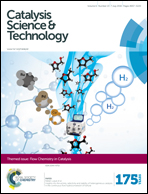On the mechanism of water oxidation catalyzed by a dinuclear ruthenium complex: a quantum chemical study†
Abstract
The development of efficient and robust catalysts for H2O oxidation is an essential element in solar water splitting. The reaction mechanism for a previously reported dinuclear Ru water oxidation catalyst (1) has been investigated in detail through quantum chemical calculations. The predicted mechanism starts from a Ru2III,III complex with two aqua ligands. After three sequential oxidations, O–O bond formation occurs at a formal Ru2IV,V state via the direct coupling of two adjacent oxo moieties while the water nucleophilic attack mechanism was found to be associated with a higher energy barrier. Two H2O molecules are then inserted with subsequent release of O2, which was found to be the rate-limiting step with a barrier of 22.7 kcal mol−1. In a previous work, it was revealed that the ligand scaffold in the studied Ru complex has a non-innocent function. Here, we further highlight this behavior, where the ligand was shown to mediate proton transfer events and accept/donate electrons during the catalytic cycle, which can significantly decrease the redox potentials and facilitate the access to high-valent redox states. This study provides further insight into the H2O oxidation mechanism and principles for designing improved catalysts for activation of small molecules, such as H2O.


 Please wait while we load your content...
Please wait while we load your content...